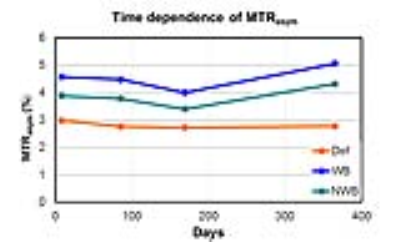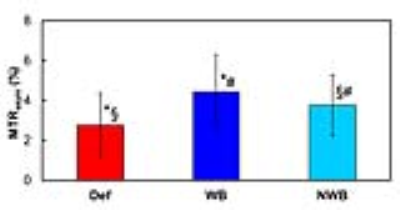Markus M. Schreiner1,2, Vladimir Mlynarik2,3, Stefan Zbyn2,4, Vladimir Juras2, Pavol Szomolanyi2, Didier Laurent5, Celeste Scotti5, Harry Haber5, and Siegfried Trattnig2,3
1Department of Orthopedics, Medical University of Vienna, Vienna, Austria, 2High-Field MR Centre, Department of Biomedical Imaging and Image-Guided Therapy, Medical University of Vienna, Vienna, Austria, 3CD Laboratory for Clinical Molecular MR Imaging, Vienna, Austria, 4Research Unit of Medical Imaging, Physics and Technology, University of Oulu, Oulu, Finland, 5Novartis Institutes for Biomedical Research, Basel, Switzerland
Synopsis
The gagCEST technique is a promising tool for
determining concentration of glycosaminoglycans in articular cartilage. In this
study, the performance of gagCEST in a group of patients with ICRS grade I-II knee
cartilage defects was investigated. It was found that the method gives significantly
different mean MTRasym values for cartilage defects, normal weight-bearing and normal
non-weight-bearing femoral cartilage. The clinical use of the gagCEST technique
is currently limited by its long measurement time and sensitivity to patient
motion.
Introduction
Evaluation of glycosaminoglycan (GAG) content in
articular cartilage is a challenging task. Among potentially useful techniques,
gagCEST is noninvasive and does not require special hardware or exogenous contrast. However, the
gagCEST effect is relatively small and the measurement is extremely sensitive
to motion.1 The aim of this study was to investigate the potential of the gagCEST technique for the assessment and monitoring of GAG content in
knee cartilage of patients with
femoral cartilage defects (ICRS grade I & II) over time of one year.Materials & Methods
Twenty-one patients (age
range, 25-55 years, mean age, 46 years) with focal cartilage lesions and risk factors for
progression (i.e., meniscal tear and ACL rupture) without surgical treatment
were prospectively enrolled in this study. The gagCEST measurements were
performed on a 7T Siemens Magnetom scanner using a 28-channel QED knee array
coil at several time points (8, 85, 169 and 365+ days from the initial date of
the study). For the gagCEST measurements, a prototype segmented 3D RF-spoiled
gradient-echo (GRE) sequence was used with TE = 3.1 ms, TR = 7.9 ms, a
field-of-view of 170 × 132 mm, a voxel size of 0.9 × 0.9 × 2.2 mm3,
30 slices, slice oversampling of 33 %, flip angle 9°, a GRAPPA accelerating
factor of 2, 19 saturation offsets with a step of 92 Hz in the whole range of
±2.8 ppm from the water resonance, and a scan time of 19 min. The saturation pulse
train consisted of ten 60-ms adiabatic full-passage hyperbolic secant (hs2)
pulses with 20 ms interpulse delays, resulting in B1rms,sat= 0.5 μT and a
shot TR of 1500 ms. Recent measurements were done using a saturation train of 6
hs2 pulses with 10 ms interpulse delays, 29 offsets in the same frequency range
and a scan time of 23 min. The MTRasym values were obtained from the
range of 0.5 to 2.0 ppm relative to the minimum of each individual Z-spectrum.
Region-of-interest (ROI)
analysis was performed in the defects (Def), in the weight-bearing (WB) femoral cartilage (a region in contact with tibia) and non-weight-bearing (NWB) femoral cartilage.Results
Fig. 1 shows the changes
in mean MTRasym values in different cartilage regions over time. The
mean MTRasym values were lower in defects than in normally appearing
WB and NWB cartilage. Similarly, the mean MTRasym value was higher
in WB cartilage than in NWB cartilage in all time points. No specific trend in
MTRasym over time for any cartilage type was observed, except a
minor increase in WB and NWB in the day 365+. Fig. 2 shows the mean values and
standard deviations of MTRasym obtained in all time points in
different cartilage regions. Although the standard deviation of the
measurements were relatively large, the mean values in all regions were
significantly different.Discussion and Conclusions
Stable MTRasym
values over the period of one year indicate constant GAG content during the follow-up time of
this study. The observed minor increase of MTRasym in WB and
NWB cartilage in the last measurement was most likely due to a minor modification in
the measurement protocol providing a more detailed sampling of Z-spectra. Apart
from an inter-subject variability and a potential time evolution of the MTRasym
values, the larger MTRasym variability in specific cartilage regions
is due to random measurement errors. Thus, the results suggest that the gagCEST
technique is suitable for assessing normal and pathological cartilage
composition in a study cohort. On the other hand, further improvements in
the sensitivity of the hardware and repeatability of the protocol are necessary
to provide accurate
information on individual patients.Acknowledgements
No acknowledgement found.References
1. Schreiner
MM, Zbyn S, Schmitt B, et al. Magn
Reson Mater Phys. 2016;29:513–521.

